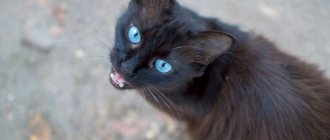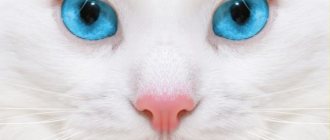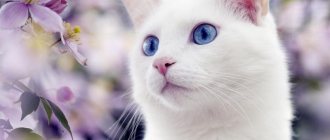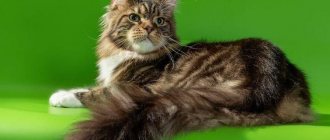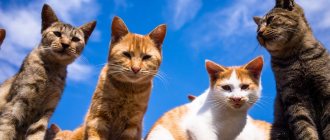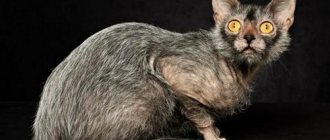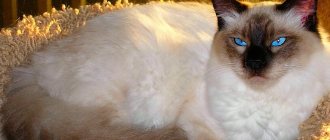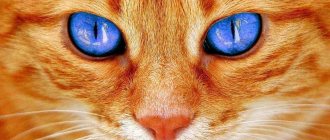Ginger cats are very popular. And it’s not surprising - this common cat color pleases the eye and lifts the mood. “Ryzhiki” are often found on the streets, but they can also be seen at any cat show. Red (more precisely, red) color is allowed by the standards of many breeds, although it is not the only “signature” color for any breed.
And yet this is a special color. Most colors of cat fur coats are determined by the black pigment gene. And the red color is determined by the “personal” red pigment gene, which has some interesting properties.
Firstly, most ginger cats are males. The pigment genes are localized on the sex X chromosome, and since the cat has only one (received from the mother), his chances of being born red are higher. A cat has two X chromosomes and will only be born red if it receives the red pigment gene from both parents.
Secondly, there are no red cats without a pattern. The fact is that some cats (including red ones) have a special gene called “non-agouti”, which does not allow the pattern (tabby) to appear. However, the red pigment gene “neutralizes” the effect of the non-agouti gene, so there are always at least traces of tabby on a red cat’s coat.
So it seems that a red cat without any signs of stripes, stains and spots cannot have the red pigment gene. Most likely, its color is cinnamon, and this is the work of the black pigment gene.
The remarkable red coloration is often found in the following breeds.
British (shorthair and longhair)
A nice, strong body, a cheeky muzzle and thick plush fur are for some reason associated with blue or chinchilla colors. In fact, the standard allows for almost all colors, and the red Briton is an impressive sight!
At one time, Persians were used for breeding by the British, so the birth of long-haired kittens was common. The “heavy Persian heritage” has long been considered a breed defect. Only recently have enthusiasts managed to achieve recognition of a new breed - the British Longhair.
The influence of genetics on cat color
There are two main colors responsible for variations in the colors of a cat’s fur coat:
- black;
- red.
Each color is formed due to a complex pigment - melanin, which is divided into two chemical subtypes:
- zumelanin (gene B) - is responsible for the black color and its derivatives;
- pheomelanin (gene A) - produces all shades of red.
The genes responsible for producing red (O - dominant) or black (o - recessive) offspring are located on the X chromosome. The color of a kitten's fur directly depends on the gender of the parents:
- cats have one X chromosome and one Y chromosome (XY);
- Cats have two X chromosomes (XX).
The kitten inherits one of the chromosomes from each parent. From the mother it will always be X, and from the father X or Y.
Just like in humans, female cats have a set of XX chromosomes, and males have XY chromosomes.
Two cat chromosomes (XX) are responsible for three basic colors:
- OO - red;
- oo - black;
- Oo - tortoiseshell (red-black).
The color of cats directly depends on which gene is carried by the only X chromosome of the parent - O or o. If there is an “O” gene on the only X chromosome of a cat, the cat will be red, but if there is an “o”, it will be black. Tortoiseshell cats appear only in the case of gene mutations and cannot have offspring.
If the parent X chromosome carries the O gene, the cat will be red, and if O, the cat will be black.
The white color stands out separately (although it is not a color at all, but rather its absence). If a cat is not an albino, then it is a carrier of some color.
Genetics of gray color
In felinology, the gray color of a cat's coat is called blue. In fact, the blue color is a bleached black. In gray pets, the dominant black gene B (Black) is diluted by the recessive light gene d. The black pigment (zumelanin), under the influence of the light gene, is not distributed evenly in the hair, but as if sticking together into lumps. The white spaces between the clumped zumelanin granules create a lightening effect. The less black pigment in the hair, the lighter the color of the cat.
Don Sphynx and St. Petersburg Sphynx (Peterbald)
The calling card of both breeds is the absence of hair. The standards of both allow any colors. Both Donchaks and Peterbalds come from the same cat, born in Rostov-on-Don in the late 80s. They equally love heat and hearty food. How are they different from each other?
Build and character. Donchaks are strong, muscular cats, with a wedge-shaped head with wide cheekbones and large ears set high and wide. They have a friendly, sociable character. Peterbalds are much more graceful - a slender body on thin high legs, a long tail, an elongated head and huge ears. Being descendants of Orientals and Siamese, Peterbalds are very active, talkative and affectionate.
Turkish Angora
An elegant large cat with a wedge-shaped head, long soft hair with virtually no undercoat is considered one hundred percent blonde. But in fact, the angora can have different colors, including red.
Other breeds whose standards allow red color: Siberian, Norwegian Forest, Oriental, Devon Rex, Selkirk Rex, La Perm, Canadian Sphynx.
The popularity of ginger cats is associated not only with their “joyful” appearance. According to legend, they bring success and protect the owners from the negative energy of bad people.
Breeds of cats with blue eyes are developed thanks to the knowledge of genetics. There are a large number of such types. These animals have different coat lengths, but they are usually divided as follows according to color:
- epistatically white;
- bicolor: a combination of a snow-white shade with another;
- acromelanistic (temperature-dependent) color.
Such animals are found in all groups of breeds: longhaired, semi-longhaired, shorthaired, Siamese-oriental, hairless.
Color options
Ocicat cat - description of the cat breed, red kitten
In fact, the red color is considered a mutation; a special Orange or O gene located on the X chromosome is responsible for it. For this reason, among kittens, ginger cats are most often found, not cats. This is a dominant mutation, due to which the body produces a special pigment, pheomelanin, which gives the coat a characteristic fiery hue.
Important! Each red fluffy cat is unique because the color is never solid. It usually forms fancy patterns, such as stripes, spots and various patterns.
If the special recessive diluent d is present in the genome, the animal's coat will be cream. In other cases, when Orange is present on two X chromosomes, the kitten will be born with a tortoiseshell color. Since this gene is always located on a specific chromosome, taking into account the color, it is possible to predict the color of the coat that the kittens will have. Below are the most popular combinations:
- uniform reddish tint with light spots combined with copper eyes, dark orange nose and paw pads;
- creamy red color with lighter stripes or spots;
- rich bright red combined with dark “tiger” stripes;
- golden-reddish hue interspersed with white hairs and copper or gold-colored eyes;
- light red with ears, paws and tail tip of a darker shade.
White-red
The red-and-white fluffy cat is a representative of the most popular color, which is never uniform. More often there are kittens with a tricolor or brindle color, a dark back and a white belly.
To achieve the ideal color, professional breeders do not mix red and cream representatives of the breed; the result is kittens with perfectly fiery fur.
Black and red
Cats with black and red hair look unusual; they are more often found among representatives of mixed breeds.
Pedigree pets mainly have a tortoiseshell color, including black and reddish shades characteristic of a particular breed. Marbled multi-colored cats are very beautiful and instantly attract attention. Many people get such animals precisely because of their non-standard coat.
Gray-red
Beautiful gray-red cats and cats are also no less popular compared to their counterparts with fur of a uniform fiery shade. The most spectacular color combines red, gray and white shades; such cats are often found among non-pedigree cats, but at the same time they are no less loved by their owners.
Brown and red
The combination of brown and red is not too uncommon in color; such cats are found among Maine Coons and Persians with tortoiseshell hair.
A small brown-red kitten often turns into a unique specimen with a special, unique color and character.
TOP 11 cat breeds with blue eyes
The kitten is born with a blue cornea, but it changes between the fourth and twelfth weeks. Unique breeds that do not have this cost a lot of money, have their own temperament and require special care.
Ojos Azules
A distinctive feature is the sky-tone eyes. Otherwise, they are no different in appearance from their relatives. Animals grow to medium size and have a strong build. Their skull shape is triangular and their eyes are almond-shaped.
Their temperament is calm and balanced. Adaptable to any environment. However, they do not like noise, as they are sensitive to sounds.
Unpretentious in content. They eat everything they give. But to keep them looking good, a balanced diet is recommended, as well as grooming.
More photos of the Ojos Azules breed:
You cannot mate them with other breeds with blue eyes: the kittens will be born dead.
Balinese (Balinese)
Grows small in size. It is distinguished by elongated ears and bright eyes. The semi-long-haired individual has a Siamese coloring. It has a slender build with long legs, is hardy and energetic.
Has a friendly and sociable character.
Suitable for families with children. She is devoted to her owners and follows them everywhere.
He loves walks, games, and allows you to put a leash on him. He has Siamese roots and does not tolerate rough upbringing and loneliness.
Rules for caring for black fur
It is believed that blackies need special care. This is partly true, since the black color easily fades in the sun, forming reddish tan marks. Therefore, your pet should not be allowed to stay in direct sunlight for too long.
A prudent owner will take care of the animal’s diet, including meat, eggs, cat grass and various dietary supplements.
Otherwise, the following rules of coat care must be observed, taking into account the characteristics of each breed:
- the thick undercoat of Manx cats requires careful combing; after completing the procedure, the cat’s fur can be smoothed with a comb; these animals should be bathed no more than twice a year using special shampoos and conditioners that enhance shine;
- the fluffy Maine Coon, short-haired Curl and Bombay need to be brushed with a brush-comb at least once a week;
- long-haired Persians and Siberians require especially careful care - cats should be combed daily, first with a wide-tooth comb, then worked through the fur with a slicker brush, and at the end of the procedure, with a fine-toothed comb; animals can be washed up to four times a year; after water treatments, the wool should be treated with a special product to make combing easier;
- After brushing, a curly Devon Rex must be stroked with wet hands: then the curly hairs will form neat waves by themselves.
There are no great difficulties in care. If the owner sincerely loves his pet, he will easily find time to select a diet, comb the fur, communicate and play. Well, your furry pet will reciprocate 100% and will delight you not only with its playful mood, but also with its luxurious appearance.
See the characteristics of Bombay black cats in the video below.
Mr. Cat advises: breeds not included in the TOP
There are equally beautiful cat breeds that are not included in the TOP:
- British Shorthair: Comes in a variety of colors. Their muzzle is rounded with large cheeks. The eye tone is light blue. Cats are strong and muscular, and have large dimensions. They prefer to walk rather than climb.
- Scottish Fold: Scottish Folds have varied coat colors. The iris can be a different blue tone. It acquires its final color by the age of one year.
- White Persians: This fluffy breed (with blue eyes) is very rare, prized and worth a lot of money. Often cats of this species are born deaf.
- Devon Rex: Has soft, curly fur, large ears, and a long muzzle with high cheekbones. The animal is characterized by rapid mood changes.
- Russian White: has a silky coat of medium length. The animal's physique is fragile. Temperament is calm. Eyes can be blue, amber, green.
- White Sphynx: the animal is hypoallergenic due to the lack of hair. A sign of the purebred breed is light pink skin and blue eyes. Cats of this species require careful care. They feel comfortable only at home, next to their owner.
- Kao Mani: the breed is young, unstable. Geneticists are working on this. The animal loves people and trusts everyone without exception. His fur is short and shiny. The undercoat is weak or absent.
Each cat has its own characteristics and temperament.
Choosing a pet must be taken seriously. Understand what responsibility will be placed on your shoulders. Any pet needs to be given enough attention, especially purebred ones.
Signs about red cats
They say that when a ginger cat leaves its owners, it takes their secrets with it, but it will bring joy, harmony and comfort, and with them wealth, to its new home. If she looks into the house completely by chance, you should expect a cash flow.
She feels a kindred spirit from a very long distance and chooses the owner for herself (not the other way around). So such a cat does not appear by chance.
Fire cats are among the most magical animals. Their aura is so great that both the people nearby and the house itself are influenced by it. While wiping itself at your feet, the animal will not beg for anything (although this also happens), it will leave an astral trace, share its happiness and part of its magic. Especially when the pet has green eyes. Such, by transmitting his fire, is said to be capable of making a person a carrier of superb brightness.
To push a pet away means for him a rejection of energy, of his gift. And the animal will no longer share its energy; it can even take it away from the person.
They also say that brownies live in ginger cats. Therefore, they do not live long when they have to move from one place to another.
What causes the blue and white combination?
- White dominance. The genetic code W is responsible for the white coat color and blue eyes. It is dominant, i.e. Just one copy is enough for a cat to inherit it. W prevents the formation of melanin. That is, if, for example, a kitten is genetically red, but is a carrier of W, then this color will not appear, it will be disguised. The problem with such cats is that they are often deaf from birth, since this gene also affects acoustics.
- Albinism - there are five alleles of albinism; the cats of the first two we considered have blue eyes, i.e. Siamese and blue-eyed albinos: Siamese (CSCS). This code is recessive and is inherited from both parents. In the Siamese/colorpoint breed, it provokes a partial lightening of the coat color: from black to brown (this phenomenon is called the Himalayan mutation). CSCS makes the coloring heat-sensitive: the paws, ears, tail are dark in tone, and the body is light.
- Blue-eyed albino (CACA) differs from epistatically white individuals; in CACA, genetic color is not masked and pigment is absent.
- Solid color (C).
- Burmese (CB).
- Albino with red eyes (CC).
Siamese cat
Speaking about heredity, it is worth mentioning separately about Ojos Azules cats. They have their own code - So. Ojus Azules are a rare breed, their color is colorful, but their eyes are always blue. They have no problems with either hearing or vision, unlike Siamese and epistatically white cats. However, Ojos Azules have other congenital problems, incl. skull defects, stillbirth.
All-white and part-white cats often have different eye colors. This phenomenon, which is medically called heterochromia, is associated with the distribution of melanin in the iris. If there is little pigment in one of the eyes, then it turns out blue.
Causes of blue eyes
Dominant white gene. Quite often, white cats are the owners of blue eyes. A striking example is the Turkish Angora.
Albinism. Albino cats may have blue or pink eyes.
Spotting. If the tortoiseshell color has white spots and they are in the area around the eyes, then perhaps the eyes themselves will have a blue tint.
Features of the breed. For example, Ojos Azules. It is not recommended to cross such cats with blue-eyed representatives of other breeds.
